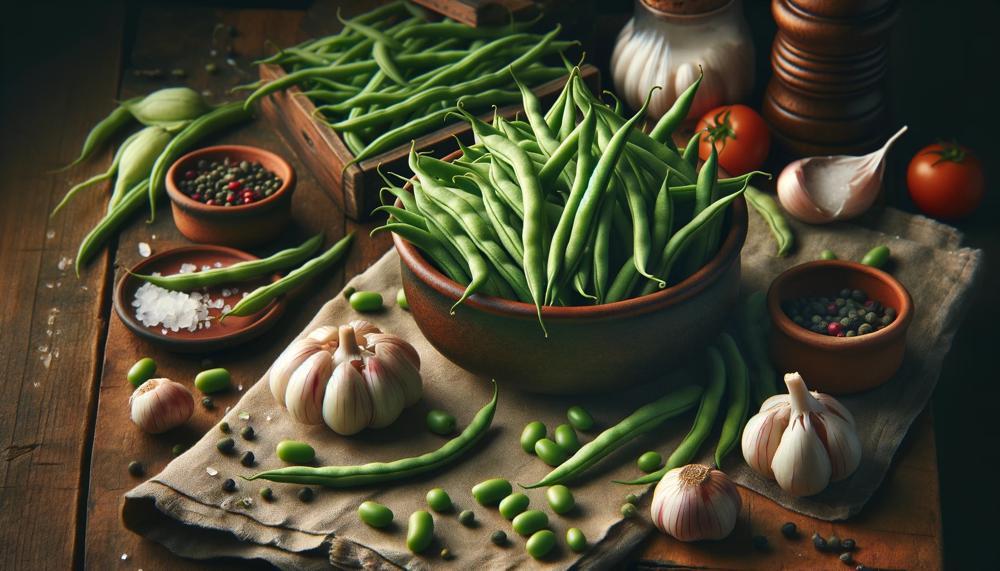Green beans are a popular and nutritious vegetable that can be enjoyed in a variety of dishes. But did you know that they can go bad if not stored or handled properly? Proper storage techniques can help extend the freshness of green beans and prevent spoilage.
In this article, I will explore the signs of spoilage, how to store green beans, the nutritional benefits they offer, and how long they typically last.
Contents
Key Takeaways:
- Green beans can go bad if not stored or handled properly.
- Signs of spoilage include changes in color, texture, and smell.
- Proper storage techniques can help extend the freshness of green beans.
- Green beans are a good source of protein, fiber, and various vitamins and minerals.
- Fresh green beans can last up to 7-10 days when properly stored.
Do Green Beans Go Bad?
Yes, green beans can go bad. Here are some signs that green beans have gone bad:
- Brown spots: Green beans that are aging may have a few brown spots, but they should still be safe to eat.
- Texture: Green beans that are spoiled may feel limp and slimy.
- Mold: Green beans that have gone bad may have fuzzy mold on them.
- Seeds: Green beans that have gone bad may have bean seed shapes that appear to be coming out of the shell.
- Smell: Green beans that are spoiled may have a sour, rotten smell.
- Cooked beans: Cooked green beans that are spoiled may give off a sour odor.
Green beans can last 5–7 days when stored in a plastic bag or airtight container in the vegetable drawer of the fridge. To keep them fresh longer, you can give them room to breathe after placing them in your fridge unwashed.
You can also store green beans in the freezer if you want them to last longer.

Signs of Bad Green Beans
When it comes to green beans, it’s important to be able to identify the signs of spoilage before consuming them. Here are some key indicators that your green beans may be past their prime:
- Loss of vibrant green color: Fresh green beans should have a vibrant green color. If you notice a dull or yellowish hue, it could be a sign of aging.
- Brown spots: Brown spots on the surface of the green beans can indicate decay or mold growth.
- Limpness: Green beans should be crisp and firm. If they appear limp or wilted, it’s a sign that they have lost their freshness.
- Slimy texture: Touch the green beans and check for a slimy surface. This sliminess is a result of bacterial growth and indicates spoilage.
- Fuzzy mold: If you discover fuzzy mold growth on the green beans, it is a clear sign that they have gone bad and should be discarded.
- Bean seed shapes protruding from the shell: When green beans age, the bean seeds may start to protrude from the shell, indicating that they are overripe and not suitable for consumption.
- “Off” smell: Some green bean varieties may emit an unpleasant odor when they have gone bad. Trust your nose and if the beans have an unusual smell, it’s best to dispose of them.
It’s important to visually inspect the green beans and check for any signs of spoilage before consuming them. By being aware of these signs, you can ensure that you only eat fresh and safe green beans.
| Signs of Bad Green Beans | Indicators |
|---|---|
| Loss of vibrant green color | Dull or yellowish hue |
| Brown spots | Decay or mold growth |
| Limpness | Wilted appearance |
| Slimy texture | Bacterial growth |
| Fuzzy mold | Clear sign of spoilage |
| Bean seed shapes protruding from the shell | Overripe and not suitable for consumption |
| “Off” smell | Unpleasant odor |
Proper Storage of Green Beans
When it comes to storing green beans, proper techniques can help maintain their freshness and extend their shelf life. Whether you prefer refrigerator storage or freezing, here are some tips to keep your green beans at their best:
Refrigerator Storage
To store green beans in the refrigerator, follow these steps:
- Place unwashed and unsnapped green beans in a plastic bag or airtight container.
- Store the bag or container in the vegetable drawer of your refrigerator.
- Ensure the temperature is set around 40°F (4°C) to maintain freshness.
- Store green beans for 5-7 days to enjoy them at their best.
By refraining from washing or snapping the beans before storage, you can help preserve their freshness and prevent moisture buildup, which can lead to spoilage.
Freezing Green Beans
If you want to store green beans for a longer period, freezing is a great option:
- Start by blanching the green beans to help maintain their color and texture. Blanching involves boiling the beans for a short period of time.
- After blanching, immediately transfer the beans to a bowl filled with ice water to cool them rapidly and stop the cooking process.
- Once the beans are completely cooled, drain them well and pat them dry with a clean towel.
- Place the blanched and dried green beans in freezer bags or containers, removing any excess air before sealing them tightly.
- Label the bags or containers with the date and store them in the freezer.
Remember to consume the frozen green beans within the recommended storage time for the best quality.
By following these proper storage techniques, you can ensure that your green beans stay fresh and ready to enjoy for longer periods.
Nutritional Benefits of Green Beans
Green beans are a nutrient-rich vegetable that offers a wide range of nutritional benefits. They are a good source of protein, fiber, folate, potassium, and vitamins K, A, and C. These essential nutrients play a vital role in maintaining a healthy diet and supporting overall well-being.
Protein is an important macronutrient that helps build and repair tissues in the body. Green beans provide a significant amount of protein, making them a valuable addition to vegetarian or vegan diets.
Fiber is another key component of green beans. It aids in digestion, promotes healthy bowel movements, and can contribute to weight management by promoting a feeling of fullness.
In addition to protein and fiber, green beans are rich in vitamins and minerals. They contain folate, which is essential for cell growth and development. Potassium helps maintain proper electrolyte balance and supports heart health. Vitamins K, A, and C are antioxidants that contribute to immune function, vision health, and collagen production.
Consuming green beans as part of a balanced diet can provide numerous health benefits. They may help lower cholesterol levels, aid in weight management, support the body’s natural detoxification system, and potentially reduce the risk of colon and breast cancer.
With their nutritional profile and versatility, green beans can be easily incorporated into a variety of dishes. From stir-fries to salads, soups, and side dishes, there are endless ways to enjoy the nutritional benefits of green beans.
How Long Do Green Beans Last?
Fresh green beans can last up to 7-10 days when properly stored in the refrigerator. Cooked green beans can last up to 4 days in the refrigerator. Frozen green beans can last several months, with the best quality within the first 6 months. Canned green beans stored in a cool, dry place can last 2-5 years or more. It’s important to check for signs of spoilage and use your best judgment when determining if green beans are still safe to consume.
Green Bean Shelf Life
Green bean shelf life can vary depending on the storage method and condition. Here’s an overview of how long green beans can last:
| Storage Method | Shelf Life |
|---|---|
| Fresh green beans (refrigerator) | 7-10 days |
| Cooked green beans (refrigerator) | 4 days |
| Frozen green beans | Several months (best quality within the first 6 months) |
| Canned green beans (stored in a cool, dry place) | 2-5 years or more |
It’s important to note that these are general guidelines and the actual shelf life may vary depending on factors such as the freshness of the green beans at the time of purchase, storage conditions, and proper handling.
Conclusion
Proper storage and handling are crucial when it comes to green beans. These nutritious vegetables can go bad if not stored correctly, leading to spoilage and a loss of freshness. By being aware of the signs of spoilage and following proper storage techniques, you can ensure that your green beans stay delicious and safe to consume.
When storing green beans, it is best to keep them in a plastic bag or airtight container in the vegetable drawer of your refrigerator. Make sure to store them unwashed and unsnapped to maintain their freshness for 5-7 days. Freezing blanched green beans is another option for long-term storage, preserving their quality for several months.
Regularly check your green beans for signs of spoilage, such as changes in color, texture, and smell. Discoloration, brown spots, limpness, slimy texture, and fuzzy mold are all indicators that the green beans have gone bad. Trust your senses, and if they don’t look or smell right, it’s best to discard them.
To enjoy green beans at their best, prioritize proper storage and handling. By doing so, you can extend their shelf life, maintain their freshness, and savor their nutritional benefits for longer periods. So, store your green beans wisely, and savor every bite.




